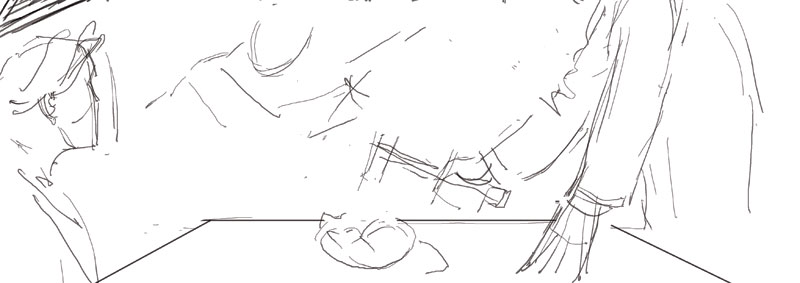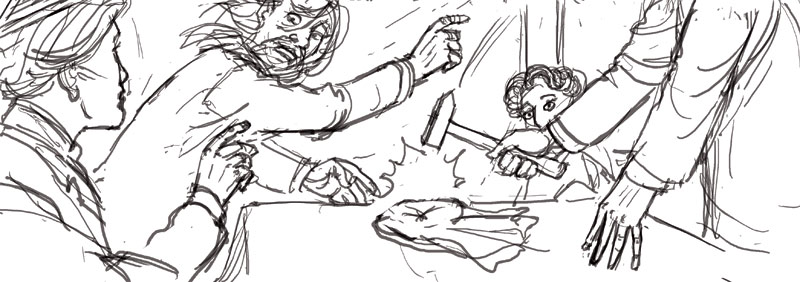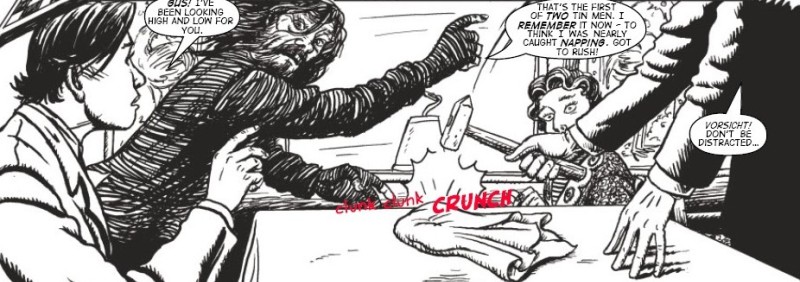Heads, Hands, Eyes: Leo explains how a panel is put together
I’ve been working on the roughs for issue six. That’s about 120 pages into the Winter book. I’ve done a little over two pages of roughs today, not great progress. I can sometimes manage five pages a day, but this scene is complicated with several characters in the same space. I’m going to look at one frame and briefly go through my process and thinking.
Actually, the process itself is rather vague, amounting simply to: get it done as efficiently as possible any which way I can. I take Dave’s thumbnail sketch as a good starting point. Dave is brilliant at taking on a lot of the groundwork in arranging the elements of frame. Sometimes I change his perspective or viewpoint, but most of the time he’s already sorted out the basics in the best way possible. That’s where the writing and drawing phases mesh.

I’ll then very roughly sketch in the characters and as little of the background as is necessary at this stage. Heads first, then vague body positions then hands. In fact, the heads and the hands often drive the whole process, they are the expression that carries the story and the dialogue. I move them around and have arms, shoulders, chest, etc. follow them, just like inverse kinetics used in 3D animation software.
At this stage I refine the overall positions of everything using the Transform tool in Photoshop. When I used to draw on paper, I would have to rub out sketches and redraw to make even small adjustments. I find scaling characters in their space something that I often get slightly wrong at the first pass or two.

Once I’m happy with general positions I then draw in more detail, but only to the minimum level I will need to ink the final black line. I concentrate on faces and eyes, wanting to pin down the emotional connections between characters. I’ll keep working on this aspect, however long it takes, because it’s critical. As in any interaction in real life, the reader will immediately look to the eyes to try and gauge the characters’ thoughts.
I then work on hands. With Jack’s hand I experimented with a more forceful pointing, but what I wanted was a hesitant gesture, a half formed, surprised attempt at stopping Gus as Jack sees him rush by. It’s like acting, I guess. I’ll even get up from my desk and test the pose – and hope the postman doesn’t catch me!

I thought about Mentallo, the guy on the right holding the hammer. His left hand is slightly supporting him on the tips of his splayed fingers. This was to emphasize the kind of personality I imagined he would have. A precise man acting out a well rehearsed entertainment routine, where even leaning on a table is done with a practiced flourish.
I’m not entirely happy with the positioning of Lady Whitmead in the background, her eyes need widening in anticipation of the hammer coming down and her head turned directly to it. She’s a simple soul, totally engrossed in Mentallo’s trick. It’ll do for now, I can give her a boost at inking. I just saw something unintentional, but sort of cool. Jack’s hand mirrors Gus’s pointing hand. This is good. Both hands emphasize Gus’s need to hurry out of the frame. The fact that Jack’s hand is accidentally sort of pointing emphasizes his failure to react fast enough to slow Gus’s advance. Incidentally, I don’t usually take my work apart like this; there isn’t time. But it’s nice to find things like this in there when you go back for a look. It suggests your subconscious is hard at work giving the necessary depth that craft alone can’t provide.
In the background of my studio I’ll be listening while I work to the radio or an audio book, but inevitably I miss big chunks as I get engrossed in figuring out the drawing. Perhaps I’ll listen to music. I’m constantly interrupted, my wife telling me not to forget to feed the chickens, and the boys asking where the Assassin’s Creed disk is. On one level annoying, on the other a gladdening reminder that I’m still in the real world and surrounded by my loved ones.

